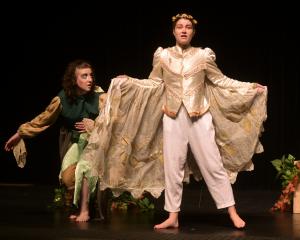By Jackson Henneveld Year 13, Waitaki Boys' High School
The 2006 film Pan's Labyrinth's sole purpose seems to be to make people hold their breath. From around the 20-minute mark, even the scenes of compassionate conversation seem to be waiting to pitch forward into shocking violence.
Guillermo del Toro somehow maintains the direction of the narrative while flawlessly jumping between children's curiosity and psychological torture, giving true depth to the characters and the world the film is set in.
Pan's Labyrinth follows Ofelia, a young girl who in a time of war, is forced to live with a cruel captain in an out-of-the-way safe-house in the country. By your first exchange with Captain Vidal, you hate him as much as it is possible to hate someone after five minutes.
Immediately he reads instability, a person of two minds; angered by something as little as Ofelia extending her left hand to acknowledge him instead of her right.
Throughout the next few minutes, however, del Toro assures the alert viewers that Vidal's split second of anger was nothing more than that, and they must have been mistaken to assume Vidal was anything but kind and just. Then, as soon as the captain seems to have calmed down, he does something that is so brutal and unjustified that it is impossible to trust him again.
Portraying Vidal's sadism so early in the film was a very clever move by del Toro, as it allows the viewers, even in his scenes of serenity, to see straight through his facade. It also creates a very eerie and alarmingly volatile environment for Ofelia's pregnant mother, who is the under full care of the captain.
This is a perfect (and rare) blend of two genres; war and fantasy. These genres are often very separate, with past attempts such as The Lion, the Witch and the Wardrobe, and Five Children and It to integrate them into one another, but del Toro forces them to react in a surprisingly original and interesting way.
In stereotypical war movies such as Saving Private Ryan, instability is a core theme - a fellow soldier could be shot in the head halfway through a nostalgic sentence, the battleship could explode at any second and World War 2 could be lost.
In Pan's Labyrinth, this is very well established, the ever-present fantasy enhancing the instability in the war-film aspects and vice-versa. This allows the characters themselves (particularly Ofelia and Captain Vidal), as well as the setting and storyline, to enhance the unpredictability in this film.
This film is often criticised for its strange portrayal of a fantasy world in a very grim, very adult period of war - especially the uncertainty behind what Ofelia sees. Was that a fairy or an insect? Is that a baby or a mandrake root?
This can be falsely interpreted as a lack of consistency, but the brutal too-real war scenes and the quieter world awash with magic and fantasy are actually told from different perspectives.
The point of the genre cross is that it is a story of two perspectives - without the opposing characters, Pan's Labyrinth could be accurately categorised as either war or fantasy, and would lack the complexity that makes it so great.
Captain Vidal never seems to interpret what Ofelia interprets, her innocent, fairy-tale view of the world is only maintained because she does not see what Vidal does.
At many points throughout the film, it is unclear whether something that has happened was seen by Ofelia or one of the adult characters, allowing the viewer to decide (to some extent) what has really happened.
But del Toro allows for viewer's interpretations. Conscious effort is required from filmgoers. Imagine having to think at the movies! If you are lazy, or easily bored by beautifully complex plot lines, this movie will only confuse you; so stick to 22 Jump Street.
For viewers willing to put in a little thought, Pan's Labyrinth will be a refreshingly deep cinematic experience. The end of the film answers every question, but leaves you with multiple answers, each as real as the last.
Del Toro lets the end of the film be interpretable, which is quite risky, but when it is well executed it adds a layer of realism that rounds the whole film off very cleanly.
The unpredictability and conflict provided by the very different main characters (and settings) gives this movie a human depth, meaning it can be related to and misunderstood at the same time.
Ultimately, it is a strength that this film can be interpreted in different ways because it does not have to target a specific audience to appeal to a variety of people.











